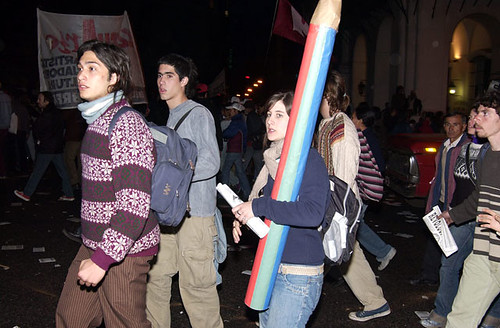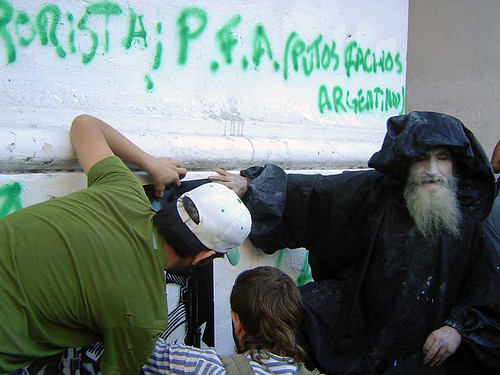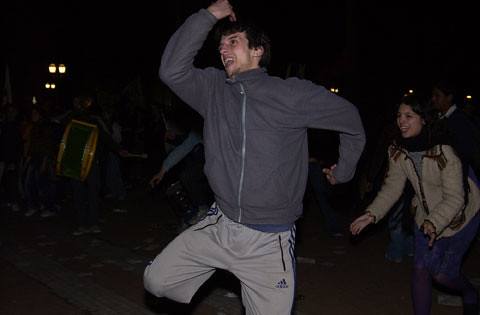On September 16, 1976 seven teenagers in La Plata were kidnapped by the government for protesting bus fares. Only one of the teens survived, the rest became part of the disappeared. Known as the Night of the Pencils it is one of the many infamous acts that occurred during Argentina’s last military dictatorship. Tonight, the 29th anniversary, a massive march was held in downtown Buenos Aires to commemorate the event. There also was a social agenda to the student marchers, the demand of wage and budget increases in the educational sector.
Early in the day there was some concern about the march as the government announced the previous night that police would again block parts of Avenida de Mayo and restrict marchers to a specified route in order to reach Plaza de Mayo. Last Friday night’s march became a tense standoff between marchers and the police. It seemed like there was the possibility for more of the same. However, midday Friday, the government changed its mind and announced that marchers would be free to walk all the way down Av de Mayo from Congreso to the Plaza. The opening of Av de Mayo was mediated by Adolfo Pérez Esquivel, who was awarded the Nobel Peace Prize in 1980 for his efforts to promote human rights in Argentina and Latin America.
Compared to last week, this evening’s march was very peaceful. Along Avenida de Mayo there were hardly any police, though a significant police presence encircled the Catedral side of Plaza de Mayo. A metal fence was erected alongside the Plaza to keep traffic flowing freely along Rivadavia, which runs westbound on the north side of the Plaza. Even in front of the Palacio Municipal (the “city hall”), often a focal point of protest for the city’s frustrated, there was only a small contingent of riot police positioned behind two metal fences that stood between them and the marchers. But, that’s hardly an unusual sight at the home of city government.
It was one of the largest marches that I have seen in Buenos Aires. Considering the tensions of last week surrounding access to Plaza de Mayo, it seems as if every group that regularly protests social issues turned out for this event. Ceci and I first watched the start of the march from a spot near Congreso across from La Inmobiliara. Once all the student groups had passed we quickly made our way down to the other end of Av de Mayo and positioned ourselves between the Cabildo and Palacio Municipal. For more than ninety minutes, group after group, each carrying their own distinctive banners and flags, marched by. Every so often, a group would stop in front of Palacio Municipal to shout and chant angry slogans at the city and to taunt the police behind the barricades.
The crowd was so large that the rally in the Plaza ended before all the marchers could arrive there. Since the police had blocked off the roads north of the Plaza, most people simply returned to Av de Mayo and marched back towards Congreso. This created a rather odd sight as you had a flow of marchers still arriving and another stream of them departing all along the same street.
The Cabildo and the Pirámide de Mayo suffered extensive graffiti coverage, most of which was of an anti-Bush nature. (Dubya is coming to Argentina in November). Remember that last week’s protest was supposed to be an anti-Bush march, but since the marchers never made it to Plaza de Mayo last week I guess they were saving their graffiti for tonight.
The crowd cleared out of Plaza de Mayo fairly quickly after the rally. Afterwards, it was mostly just small groups of students hanging around, dancing, and smoking.



September 15th, 2006 at 10:34 am
[…] Saturday, 16 September, is the 30th anniversay of La Noche de los Lápiches (The Night of the Pencils), another sad but notable event from the most recent dictatorship in Argentina. Last year I wrote extensively about the march that took place on the 29th anniversary. […]
December 5th, 2008 at 4:39 pm
Fifteen people were seized at La Plata and three people survived…Emilse Moller, Patricia Miranda, and Pablo Diaz.